We use cookies to make your experience better. To comply with the new e-Privacy directive, we need to ask for your consent to set the cookies. Learn more.
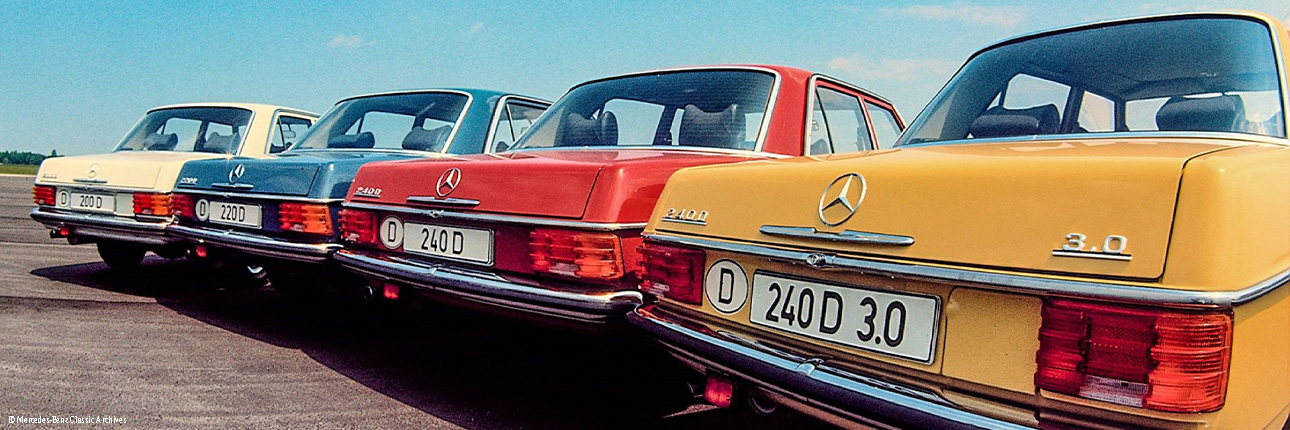
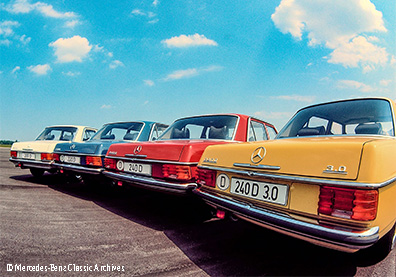
50 years ago: Mercedes-Benz in 1974
As we welcome 74 Plate vehicles into our showrooms this September, we take a look back at the landscape of Mercedes-Benz motoring 50 years ago in 1974.
4 June 1974
The ESF 24 experimental safety vehicle was presented in London.
-
Highlight of the Mercedes-Benz ESF programme in the 1970s
-
Contribution to automotive safety research based on the S-Class 116 model series
-
Design solutions for a frontal impact as the main focus
With 35 experimental safety vehicles (ESF models), Mercedes-Benz researched automotive safety systems in the 1970s as part of the international ESV programme and put them on the road to series production. Daimler-Benz presented the ESF 24 at the 5th International ESV Conference in London (4 to 7 June 1974). This vehicle, based on the S-Class of the 116 model series, focused on researching designs for a frontal impact with a rigid barrier at 65 km/h (40 mph). In 1974, Mercedes-Benz emphasised in a press release that the ESF 24 could not be regarded as a prototype for future series vehicles due to its greater length and its approximately ten per cent greater weight and the corresponding increase in fuel consumption in view of the growing scarcity of raw materials and energy. Head of Research Professor Hans Scherenberg drew this conclusion at the time: the realisation that “a period of intensive basic research must now be initiated to ensure that further advances in safety technology are based on realistic, economic grounds” were valuable.
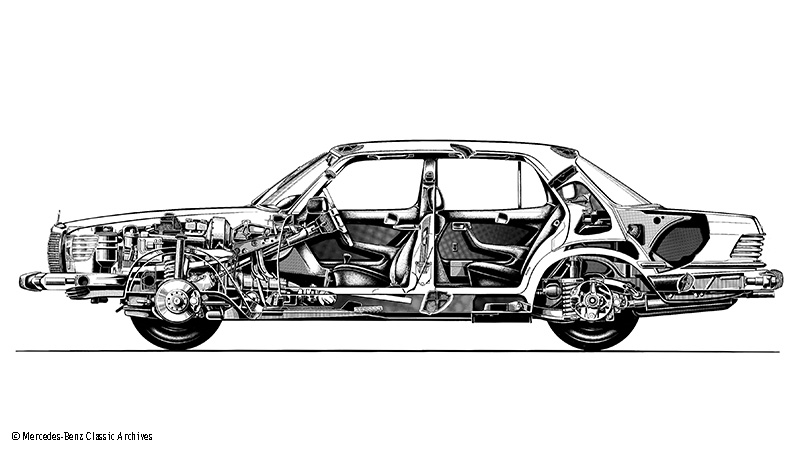 Mercedes-Benz presented the ESF 24 at the 5th International ESV Conference in London (4 to 7 June 1974). In the 1970s, the then Daimler-Benz AG researched automotive safety systems in a total of 35 experimental safety vehicles (ESF) and brought them on the road to series production. Sectional drawing from 1974.
Mercedes-Benz presented the ESF 24 at the 5th International ESV Conference in London (4 to 7 June 1974). In the 1970s, the then Daimler-Benz AG researched automotive safety systems in a total of 35 experimental safety vehicles (ESF) and brought them on the road to series production. Sectional drawing from 1974.
12 July 1974
Premiere of the first five-cylinder diesel engine passenger car in the 240 D 3.0 “Stroke Eight”.
- The world’s most powerful diesel passenger car to date had an output of 59 kW (80 hp)
- Technically closely related to the four-cylinder 240 D model
- The suffix “/8” was added to all new models in 1968
The Mercedes-Benz 240 D 3.0 with the 59 kW/80 hp three-litre five-cylinder OM 617 engine is one of the sought-after representatives of the “Stroke Eight” model series 114 and 115, production of which started in 1968. On 12 July 1974, 50 years ago, the 240 D 3.0 was presented in Frankfurt/Main and Hockenheim. The mid-size saloon of the E-Class tradition was the most powerful diesel passenger car and also the world’s first five-cylinder series-produced passenger car. The engine had the same stroke-bore ratio and the same cylinder spacing as the four-cylinder engine of the 240 D with 48 kW/65 hp. From 1974 to 1976, 53,690 units of the 240 D 3.0 were produced. The OM 617 continued to be built in the 300 D of the 123 model series until 1985. The term “Stroke Eight”, which is commonly used in classic car circles today, was created due to the addition of “/8” in internal Mercedes-Benz publications for all models released in 1968. However, the abbreviation is only used for the 114 and 115 model series in classic car parlance.
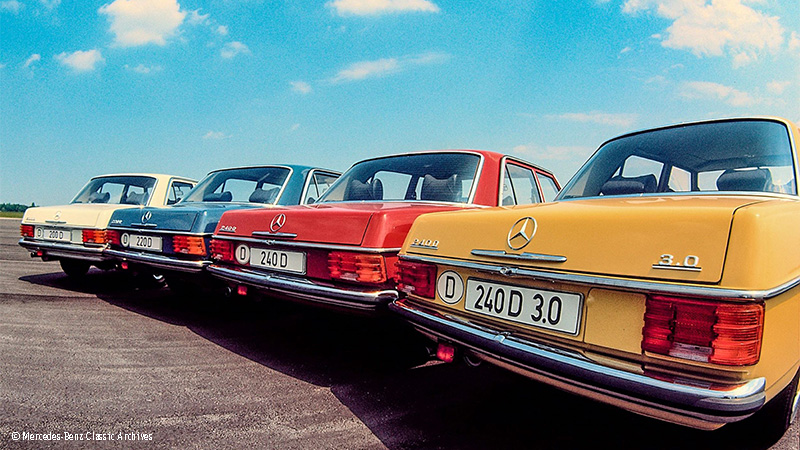 The Mercedes-Benz 240 D 3.0 (W 115) with the 59 kW/80 hp three-litre five-cylinder OM 617 engine made its debut on 12 July 1974. It was the most powerful diesel passenger car of its time and also the world’s first five-cylinder series-produced passenger car. Rear shot of a 240 D 3.0 and other models of the “Stroke Eight” model series 115 and 114.
The Mercedes-Benz 240 D 3.0 (W 115) with the 59 kW/80 hp three-litre five-cylinder OM 617 engine made its debut on 12 July 1974. It was the most powerful diesel passenger car of its time and also the world’s first five-cylinder series-produced passenger car. Rear shot of a 240 D 3.0 and other models of the “Stroke Eight” model series 115 and 114.
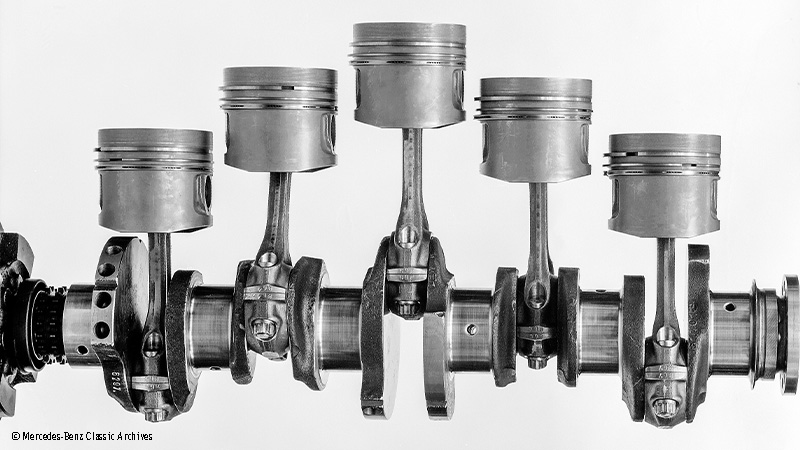 Shot of the crankshaft with five pistons.
Shot of the crankshaft with five pistons.
15 July 1974
18 Mercedes-Benz fans founded the Mercedes-Benz Club of South Australia.
- Diverse commitment for a lively club life
- 80 officially recognised Mercedes-Benz brand clubs worldwide with around 100,000 members
- Promoting and enhancing the shared enjoyment of owning a Mercedes-Benz
The primary aim of the Mercedes-Benz Club of South Australia is to promote and enhance the enjoyment of owning a Mercedes-Benz. This has been happening with like-minded people for 50 years now. In early 1974, Reverend Clem Minge placed an advert in the Adelaide local newspaper “The Advertiser” inviting people to form a Mercedes-Benz brand club. On 30 June 1974, eleven Mercedes-Benz drivers and their cars accepted the invitation. The second meeting on 15 July 1974 was attended by 18 fans of the brand. Now the club was born, and Clem Minge was elected president. For 50 years, the club has been involved in classic car events, visits to local workshops and car collections, and participation in national rallies. The club, based in Edwardstown near Adelaide in South Australia, has long been officially recognised by Mercedes-Benz as a brand club. It is now one of some 80 Mercedes-Benz clubs and communities with approximately 130,000 members worldwide. Every club lives the enthusiasm and passion for mobility, the community and the exchange of expertise among its members. 65 years ago, in 1959, the first passenger car had already rolled off the production line of the Mercedes-Benz assembly plant in Melbourne, an hour and a half flight east of Adelaide. It was a 220 S (W 180).
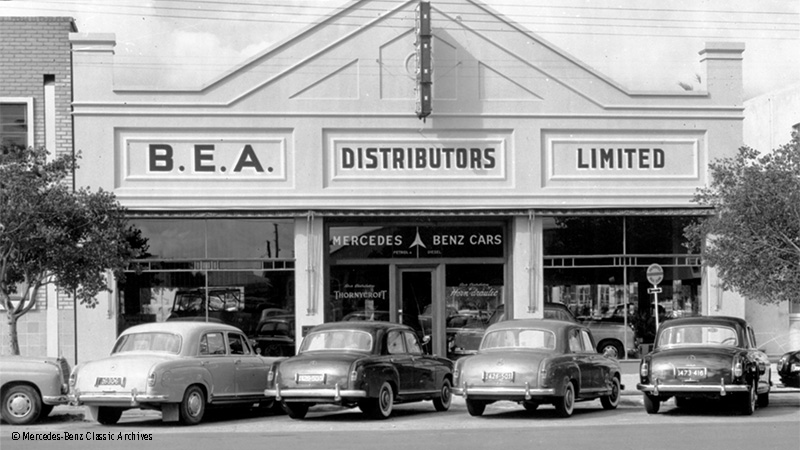 The Mercedes-Benz Club of South Australia was founded in Adelaide in 1974. It is one of the 80 officially recognised Mercedes-Benz brand clubs worldwide with a total of around 100,000 members. Photo of the Mercedes-Benz agency B.E.A. in Adelaide, 1955.
The Mercedes-Benz Club of South Australia was founded in Adelaide in 1974. It is one of the 80 officially recognised Mercedes-Benz brand clubs worldwide with a total of around 100,000 members. Photo of the Mercedes-Benz agency B.E.A. in Adelaide, 1955.
